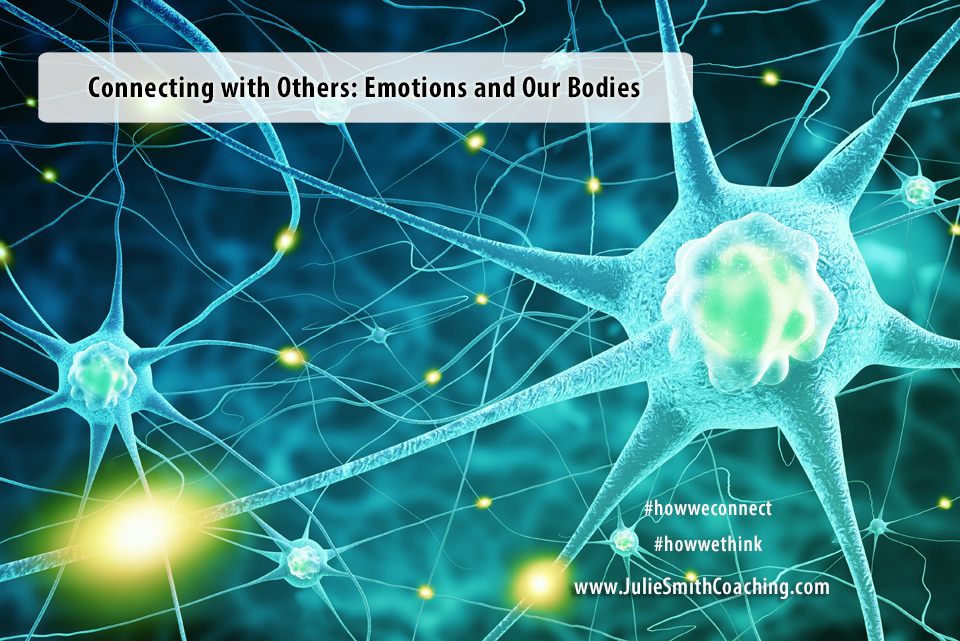 In an earlier post, Don’t Believe Everything Your Thoughts Tell You, we talked about how neuroscience shows that every thought you have causes complex chemical reactions in your body that affect how you feel. Through a chemical reaction, in your body, your thoughts interact with your emotions. This has a huge impact on how we connect with and interact with others.
In an earlier post, Don’t Believe Everything Your Thoughts Tell You, we talked about how neuroscience shows that every thought you have causes complex chemical reactions in your body that affect how you feel. Through a chemical reaction, in your body, your thoughts interact with your emotions. This has a huge impact on how we connect with and interact with others.
People, especially leaders, often encourage you to “Leave emotions out of it.” The fact is, your emotions and thoughts always influence each other. They influence your body, too, and signal it to prepare and respond to threat or opportunity. This mind/body connection affects heart rate, blood pressure, digestion, immunity, muscle response, energy levels and even body temperature.
There’s this kind of two-way communication system occurring at all times in our bodies. According to one organization that studies and teaches about emotional intelligence, appropriately named Six Seconds, “It takes about six seconds for an emotion chemical to travel through the body, deliver its message to a cell, and be recycled.”
That’s not very long when it comes to how we respond to our interactions with others in our day to day lives. But it’s long enough to be mindful, aware, and choose a response rather than react.
Emotional Intelligence
We’ve all heard, and maybe even read about, the term Emotional Intelligence. What is it? Basically, it’s our ability to identify, understand, and handle our own emotions as well as those of others around us. According to Six Seconds, it simply means “being smarter with feelings. It’s about putting together the rational and emotional so you can move forward effectively.”
Today, we live in a complex world. Chronic stress exists in our lives at work, at home, and in our society both nationally and globally. Advancing technology both connects and isolates us. Even our children begin to feel the effects.
It becomes more difficult to solve problems that we face as individuals and in groups or society because emotions are often charged. We’re impatient. We’re frazzled. Our bodies are often in that state of “fight or flight,” reacting to the stress around us.
It’s never been more important to develop our skills of emotional intelligence; to learn the skills to identify and handle our own and others’ emotions effectively. Increasing amounts of research are showing that developing our skills in emotional intelligence helps people form stronger relationships, make better decisions, be and feel healthier, and create more effective results in work and life.
Awareness of Physical Feelings First
Have you learned, over time, to ignore your feelings? To sweep them under the rug? If so, it can be a challenge to start really tuning into those feelings. Since emotions are part of the biology of your body, lets start there with a simple practice you can do several times a day:
- Notice what you are experiencing physically. (e.g. tight jaw, sore back, fists clenched, shallow breathing, tight muscles, frown)
- What kind of thinking are you doing? (e.g. focused, distracted, analyzing, observing, imaginative)
- What feelings are you experiencing? (e.g. worried, agitated, calm, bored, excited, happy)
Practicing in this way helps you to become better at noticing your feelings, big or small. With this knowledge you can begin to apply insight to those feelings and think about how you can choose to respond vs. simply reacting.
This articles begins a series on emotional intelligence and my goal is to provide you with some simple actions that you can begin to take right away to hone your emotional intelligence skills and improve how you connect with others.
Learn it. Apply it.
- How might stress in your life and the world around you be affecting your interactions, both professional and personally?
- In what ways might you be more effective by developing your ability to identify and handle your own and others’ emotions?
- What do you notice that you experience, physically, throughout your day?
- What kind of thinking are you doing when you experience that physical sensation?
- What are your feeling, emotionally, with that physical sensation?
*Concepts adapted from Practicing Emotional Intelligence by Six Seconds.

 Julie Smith is a certified Life Coach, Leadership Coach and Health Coach. She empowers others to create calm and clarity through work and life transitions. Together, they build confidence, create postive change, and greater well-being so they can lead themselves and the organizations and families they serve. Her clients include purpose-driven professionals, leaders and organizations.
Julie Smith is a certified Life Coach, Leadership Coach and Health Coach. She empowers others to create calm and clarity through work and life transitions. Together, they build confidence, create postive change, and greater well-being so they can lead themselves and the organizations and families they serve. Her clients include purpose-driven professionals, leaders and organizations.